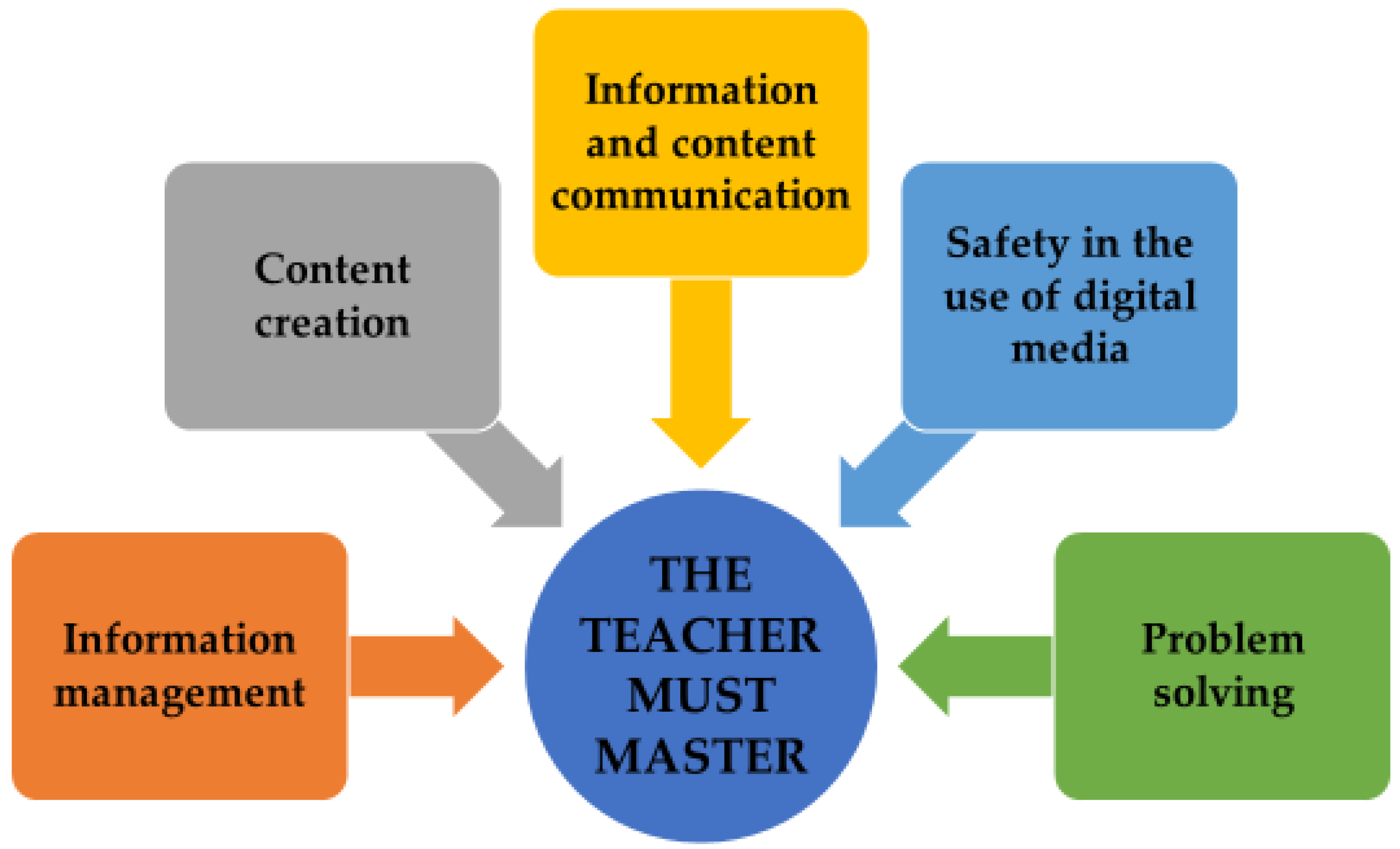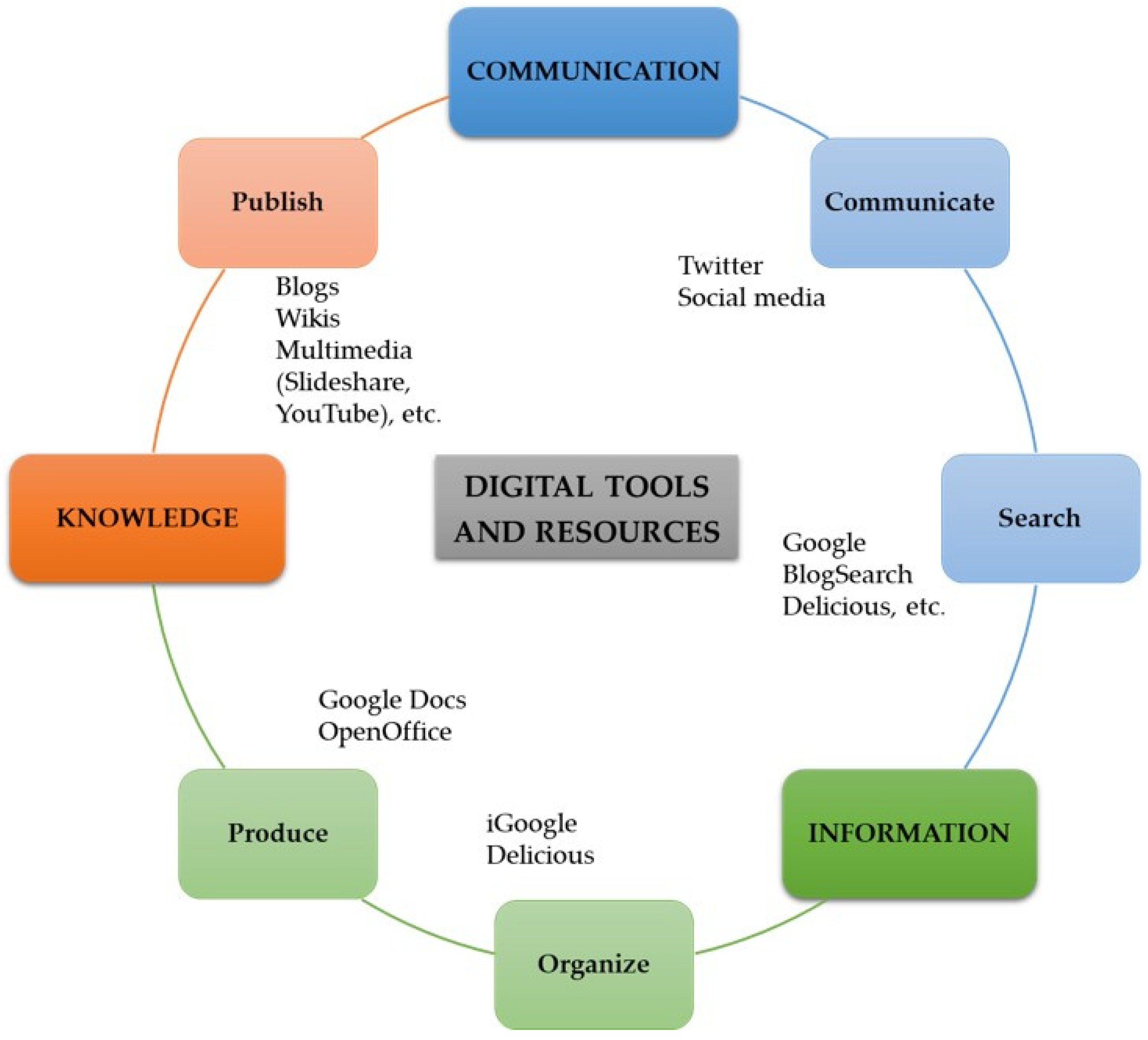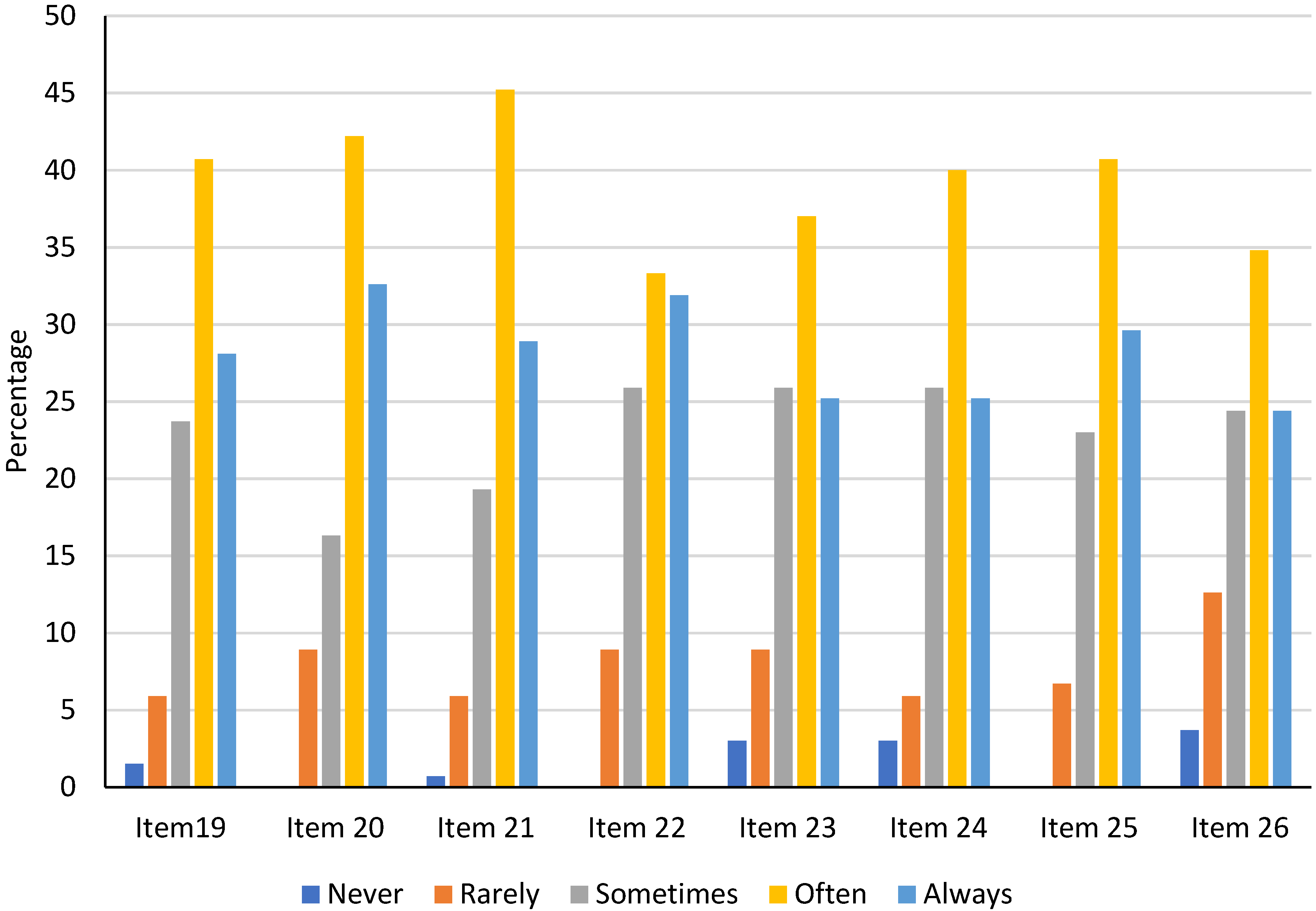Digital Resources and Digital Competence: A Cross-Sectional Survey of University Students of the Childhood Education Degree of the University of Jaén
Abstract
:1. Introduction
- General (cross-curricular) competencies, divided into instrumental, personal and systemic. They are understood as capacities and skills that can be used in many situations, not only in those related to the specific area of study, and thus they are transferable and common to any degree.
- Specific competencies, linked to the study areas (theoretical, practical and/or experimental knowledge and specific skills of the area) that refer to the appropriate and pertinent methods and techniques of each area [1].
2. Theoretical Framework
- Do our students (future teachers) know the digital resources and tools?
- Have university professors used these resources to teach the subjects?
- Will our students know how to create appropriate digital resources for their future pupils?
- Will our students know how to collaborate with other teachers and parents on the selection, creation, modification and protection of educational digital resources?
- Identify what the students of the Childhood Education Degree of the University of Jaén use digital resources for.
- Determine if there are significant differences based on gender in the use of digital resources by the students of the Childhood Education Degree of the University of Jaén.
- Determine if there are significant differences in the use of digital resources by the students of the Childhood Degree of the University of Jaén depending on the course.
- Determine if there are significant differences in the use of digital resources by the students of the Childhood Degree of the University of Jaén based on age.
3. Materials and Methods
3.1. Procedure
3.2. Sample
3.3. Instrument
- Item 19. The use of digital resources for learning improves your ability to solve problems (for example: digital libraries, institutional resource centers, repositories, portals, online courses, books, articles, digital teaching materials, guides, blogs, forums, social networks, etc.).
- Item 20. The use of digital resources for learning supports the creation of new ideas and content.
- Item 21. The use of digital resources in your learning favors the level of security and confidence during the development of your school activities.
- Item 22. The use of digital resources in your learning stimulates your interest in the studied subject.
- Item 23. The use of digital resources in your learning favors social and communication skills.
- Item 24. The use of digital resources in your learning favors cooperation and collaborative work in the development of common tasks.
- Item 25. The digital resources to which you have access respond to your learning needs and/or interests.
- Item 26. The digital resources offered by ILIAS (Integriertes Lern-, Informations- und Arbeitskooperations System is the German acronym for Integrated Learning, Information and Cooperation System; it is the online platform used by the University of Jaén to facilitate teaching and learning tasks for students and teachers) make learning easier for you.
4. Results
4.1. Descriptive Statistics
4.2. Analysis of Variance
5. Discussion
6. Conclusions
Author Contributions
Funding
Acknowledgments
Conflicts of Interest
References
- Bolívar, A. La planificación por competencias en la reforma de Bolonia de la educación superior: Un análisis crítico. ET-Educ. Temática Digit. 2007, 9, 68–94. Available online: https://nbn-resolving.org/urn:nbn:de:0168-ssoar-73427 (accessed on 10 May 2021). [CrossRef]
- Marentic-Pozarnik, B. From Green to Red Tomatoes or Is there a Shortcut by which to Change the Conceptions of Teaching and Learning of College Teachers? High. Educ. Eur. 1998, 23, 331–338. [Google Scholar] [CrossRef]
- Real Decreto 1393/2007, de 29 de Octubre, por el que se Establece la Ordenación de las Enseñanzas Universitarias Oficiales. BOE N° 260, del 30 de octubre de 2007. Available online: https://www.boe.es/buscar/pdf/2007/BOE-A-2007-18770-consolidado.pdf (accessed on 14 May 2021).
- Pérez Ferra, M. Evaluación y Desarrollo de las Competencias Comunicativa y Digital en Estudiantes del Grado de Maestro; Graó: Barcelona, Spain, 2019. [Google Scholar]
- ANECA. Libro Blanco. Título de Grado en Magisterio; Volume 1. 2004. Available online: http://www.aneca.es/var/media/150404/libroblanco_jun05_magisterio1.pdf (accessed on 17 May 2021).
- ANECA. Documentos y publicaciones. Libros Blancos. 2004. Available online: http://www.aneca.es/Documentos-y-publicaciones/Libros-Blancos (accessed on 17 May 2021).
- European Commission. Safe and Critical Use of Information Society Technologies (IST) for Work, Leisure and Communication. 2006. Available online: https://eur-lex.europa.eu/legal-content/EN/TXT/PDF/?uri=CELEX:32006H0962 (accessed on 21 May 2021).
- Durán, M.; Gutiérrez, I.; Prendes, M.P. Análisis conceptual de modelos de competencia digital del profesorado universitario. RELATEC Rev. Latinoam. Tecnol. Educ. 2016, 15, 97–114. [Google Scholar]
- Carretero, S.; Vuorikari, R.; Punie, Y. DigComp 2.1. The digital Competence Framework for Citizens with Eight Proficiency Levels and Examples of Use. 2017. Available online: http://publications.jrc.ec.europa.eu/repository/bitstream/JRC106281/web-digcomp2.1pdf_(online).pdf (accessed on 15 May 2021).
- European Commissión Europea. DigCompOrg. Digitally Competent Educational Organisations. 2016. Available online: https://ec.europa.eu/jrc/en/digcomporg (accessed on 21 May 2021).
- Gisbert, M. Una Tecnología Educativa para la Era Digital. Manuscrito no Publicado, Proyecto de Cátedra; Universidad Rovira i Virgili: Tarragona, Spain, 2017. [Google Scholar]
- INTEF; Instituto Nacional de Tecnologías Educativas y de Formación del Profesorado. Marco Común de Competencia Digital Docente. 2017. Available online: https://intef.es/Noticias/marco-comun-de-competencia-digital-docente-2017-intef/ (accessed on 24 May 2021).
- Gutiérrez, I. Perfil del profesor universitario español en torno a las competencias en tecnologías de la información y la comunicación. Píxel-Bit. Rev. Medios Educ. 2014, 44, 51–65. [Google Scholar] [CrossRef]
- Ferrari, A. DIGCOMP: A Framework for Developing and Understanding Digital Competence in Europe; JRC-IPTS: Seville, Spain, 2013; Available online: http://ipts.jrc.ec.europa.eu/publications/pub.cfm?id=6359 (accessed on 12 May 2021).
- Cabero-Almenara, J.; Palacios-Rodríguez, A. Marco Europeo de Competencia Digital Docente «DigCompEdu» y cuestionario «DigCompEdu Check-In». EDMETIC Rev. Educ. Mediática TIC 2020, 9, 213–234. [Google Scholar] [CrossRef] [Green Version]
- Orden de 29 de Marzo de 2021, por la que se Establecen los Marcos de la Competencia Digital en el Sistema Educativo no Universitario de la Comunidad Autónoma de Andalucía. Boletín Oficial de la Junta de Andalucía, N° 67, 150–162. Available online: https://www.juntadeandalucia.es/educacion/portals/delegate/content/50599994-ac98-4feb-870f-a0b04081aa75 (accessed on 21 May 2021).
- Cabero-Almenara, J.; Barroso-Osuna, J.; Rodríguez-Gallego, M.; Palacios-Rodríguez, A. La Competencia Digital Docente. El caso de las universidades andaluzas. Aula Abierta 2020, 49, 363–372. [Google Scholar] [CrossRef]
- Martínez-Serrano, M.C. Percepción de la Integración y uso de las Tecnologías de la Información y la Comunicación (TIC). Estudio de Profesores y Estudiantes de Educación Primaria. Inf. Tecnológica 2019, 30, 237–246. [Google Scholar] [CrossRef] [Green Version]
- Colomé, D. Objetos de aprendizaje y recursos educativos abiertos en Educación Superior. EDUTEC-Rev. Electrónica Tecnol. Educ. 2019, 69, 89–101. [Google Scholar] [CrossRef]
- Manrique-Losada, B.; Zapata Cárdenas, M.I.; Arango Vásquez, S.I. Entorno virtual para cocrear recursos educativos digitales en la educación superior. Campus Virtuales 2020, 9, 101–112. [Google Scholar]
- Pérez-Ortega, I. Creación de Recursos Educativos Digitales: Reflexiones sobre Innovación Educativa con TIC. Int. J. Sociol. Educ. 2017, 6, 244–268. [Google Scholar] [CrossRef] [Green Version]
- Hyman, H.H. Survey Design and Analysis Principles, Cases, and Procedures; The Free Press: Ontario, ON, Canada, 1955. [Google Scholar]
- Morales, P. Estadística Aplicada a las Ciencias Sociales: La Fiabilidad de los Tests y Escalas; Universidad Pontificia de Comillas: 2007. Available online: http://www.upcomillas.es/personal/peter/estadisticabasica/Fiabilidad.pdf (accessed on 28 May 2021).
- Ocaña, M.T.; Pérez, M.; Quijano, R. Elaboración y validación de una escala de creencias de los alumnos de Educación Secundaria Obligatoria respecto al medio ambiente. Profesorado 2013, 17, 432–454. Available online: https://www.ugr.es/~recfpro/rev171COL10.pdf (accessed on 28 May 2021).
- Cervantes, M.L.P.; Barros, A.F.S. Importancia del uso de las plataformas virtuales en la formación superior para favorecer el cambio de actitud hacia las TIC: Estudio de caso: Universidad del Magdalena, Colombia. Rev. Iberoam. Evaluación Educ. 2013, 6, 153–166. [Google Scholar]
- Padilla Carmona, M.T.; Suárez Ortega, M.; Sánchez García, M.F. Inclusión digital de los estudiantes adultos que acceden a la universidad: Análisis de sus actitudes y competencias digitales. Rev. Complut. Educ. 2016, 27, 1229–1246. [Google Scholar] [CrossRef] [Green Version]
- Pérez-Navío, E.; Medina-Domínguez, M.C.; Cachón-Zagalaz, J. Perception of the professional competences of last year’s students of Pre-Primary Education and Primary Education degrees and students of training Teachers Master. NAER J. New Approaches Educ. Res. 2019, 8, 58–65. [Google Scholar] [CrossRef]
- Peinado Camacho, J.D.J. Experiencias del profesorado acerca del aprendizaje autónomo en estudiantes de modalidad a distancia y el uso de recursos digitales. RIDE Rev. Iberoam. Investig. Desarro. Educ. 2020, 10. [Google Scholar] [CrossRef] [Green Version]
- Valencia, A.J.A.; Moreno, P.D.C. El uso de las TIC como herramienta de motivación para alumnos de enseñanza secundaria obligatoria. Estudio de caso español. Hamut’ay 2019, 6, 37–49. [Google Scholar] [CrossRef]
- Garrido, M.C.D.; Ruiz-Cabezas, A.; Domínguez, M.C.M.; Dueñas, M.C.L.; Pérez Navío, E.; Rivilla, A.M. La formación de docentes en el diálogo y el entendimiento intercultural: Con foco en la educación para un desarrollo sostenible. Sustainability 2020, 12, 9934. [Google Scholar] [CrossRef]
- Del Moral Pérez, M.E.; Martínez, L.V.; Piñeiro, M.D.R.N. Habilidades sociales y creativas promovidas con el diseño colaborativo de digital storytelling en el aula. Digit. Educ. Rev. 2016, 30, 30–52. [Google Scholar]
- Guillén-Gámez, F.D.; Mayorga-Fernández, M.J.; Contreras-Rosado, J.A. Incidence of Gender in the Digital Competence of Higher Education Teachers in Research Work: Analysis with Descriptive and Comparative Methods. Educ. Sci. 2021, 11, 98. [Google Scholar] [CrossRef]
- Gómez Carrasco, C.J.; Chaparro Sainz, Á.; Felices de la Fuente, M.D.M.; Cózar Gutiérrez, R. Estrategias metodológicas y uso de recursos digitales para la enseñanza de la historia: Análisis de recuerdos y opiniones del profesorado en formación inicial. Aula Abierta 2020, 49, 65–74. [Google Scholar] [CrossRef]
- Masanet, M.J.; Pires, F.; Gómez-Puertas, L. Riesgos de la brecha digital de género entre los y las adolescentes. Prof. Inf. 2021, 30, e300112. [Google Scholar] [CrossRef]
- Martínez-Cantos, J.L.; Castaño, C. La brecha digital de género y la escasez de mujeres en las profesiones TIC. Panor. Soc. 2017, 25, 49–65. [Google Scholar]
- Velázquez, S.C.A.; Amador, E.M.P. La brecha digital de género como factor limitante del desarrollo femenino. Boletín Científico Investigium Esc. Super. Tizayuca 2020, 5, 22–27. [Google Scholar] [CrossRef]
- Alberola-Mulet, I.; Iglesias-Martínez, M.J.; Lozano-Cabezas, I. Teachers’ Beliefs about the Role of Digital Educational Resources in Educational Practice: A Qualitative Study. Educ. Sci. 2021, 11, 239. [Google Scholar] [CrossRef]
- Cabea, A.R.C.; Domínguez, M.d.C.M.; Navio, E.P.; Rivilla, A.M. University teachers’ training: The Digital Competence. [Formación del profesorado Universitario en la Competencia Digital]. Pixel-Bit. Rev. Medios Educ. 2020, 58, 181–215. [Google Scholar] [CrossRef]



| Cross-Curricular Competencies |
| INSTRUMENTAL |
| Capacity for analysis and synthesis |
| Organizational and planning skills |
| Oral and written communication in the mother tongue |
| Knowledge of a foreign language |
| Ability to manage information |
| Computer knowledge related to the field of study |
| Problem resolution |
| Decision making |
| PERSONAL |
| Teamwork |
| Work in an interdisciplinary team |
| Work in an international context |
| Skills in interpersonal relationships |
| Recognition of diversity and multiculturalism |
| Critical thinking |
| Ethical commitment |
| SYSTEMIC |
| Autonomous learning |
| Adaptation to new situations |
| Creativity |
| Leadership |
| Knowledge of other cultures and customs |
| Initiative and entrepreneurship |
| Motivation for quality |
| Sensitivity towards environmental issues |
| Course | |||
| 1° | 2° | 3° | 4° |
| 20.3% | 4.5% | 26.6% | 9.5% |
| Gender | |||
| Male | Female | ||
| 6.7% | 93.3% | ||
| Age | |||
| 18–20 | 21–23 | 24–26 | ≥27 |
| 25.9% | 50.5% | 20.7% | 2.9% |
| Item | %1 | %2 | %3 | %4 | %5 | Mean | Standard Deviation |
|---|---|---|---|---|---|---|---|
| 19. The use of digital resources for learning improves your ability to solve problems | 1.5 | 5.9 | 23.7 | 40.7 | 28.1 | 3.88 | 0.939 |
| 20. The use of digital resources for learning supports the creation of new ideas and content | 0 | 8.9 | 16.3 | 42.2 | 32.6 | 3.99 | 0.922 |
| 21. The use of digital resources in your learning favors the level of security and confidence during the development of your school activities | 0.7 | 5.9 | 19.3 | 45.2 | 28.9 | 3.96 | 0.888 |
| 22. The use of digital resources in your learning stimulates your interest in the studied subject | 0 | 8.9 | 25.9 | 33.3 | 31.9 | 3.88 | 0.962 |
| 23. The use of digital resources in your learning favors social and communication skills | 3 | 8.9 | 25.9 | 37 | 25.2 | 3.73 | 1.033 |
| 24. The use of digital resources in your learning favors cooperation and collaborative work in the development of common tasks | 3 | 5.9 | 25.9 | 40 | 25.2 | 3.79 | 0.988 |
| 25. The digital resources to which you have access respond to your learning needs and/or interests | 0 | 6.7 | 23 | 40.7 | 29.6 | 3.93 | 0.891 |
| 26. The digital resources offered by ILIAS make learning easier for you | 3.7 | 12.6 | 24.4 | 34.8 | 24.4 | 3.64 | 1.097 |
| Item | Gender | Age | Course | |||
|---|---|---|---|---|---|---|
| Student’s | ANOVA | |||||
| t | MD | F | Sig. | F | Sig. | |
| The digital resources offered by ILIAS make learning easier for you | −0.859 | −0.325 | 0.96 | 0.41 | 4.16 | 0.007 |
Publisher’s Note: MDPI stays neutral with regard to jurisdictional claims in published maps and institutional affiliations. |
© 2021 by the authors. Licensee MDPI, Basel, Switzerland. This article is an open access article distributed under the terms and conditions of the Creative Commons Attribution (CC BY) license (https://creativecommons.org/licenses/by/4.0/).
Share and Cite
Martínez-Serrano, M.d.C.; Ocaña-Moral, M.T.; Pérez-Navío, E. Digital Resources and Digital Competence: A Cross-Sectional Survey of University Students of the Childhood Education Degree of the University of Jaén. Educ. Sci. 2021, 11, 452. https://doi.org/10.3390/educsci11080452
Martínez-Serrano MdC, Ocaña-Moral MT, Pérez-Navío E. Digital Resources and Digital Competence: A Cross-Sectional Survey of University Students of the Childhood Education Degree of the University of Jaén. Education Sciences. 2021; 11(8):452. https://doi.org/10.3390/educsci11080452
Chicago/Turabian StyleMartínez-Serrano, María del Carmen, María Teresa Ocaña-Moral, and Eufrasio Pérez-Navío. 2021. "Digital Resources and Digital Competence: A Cross-Sectional Survey of University Students of the Childhood Education Degree of the University of Jaén" Education Sciences 11, no. 8: 452. https://doi.org/10.3390/educsci11080452
APA StyleMartínez-Serrano, M. d. C., Ocaña-Moral, M. T., & Pérez-Navío, E. (2021). Digital Resources and Digital Competence: A Cross-Sectional Survey of University Students of the Childhood Education Degree of the University of Jaén. Education Sciences, 11(8), 452. https://doi.org/10.3390/educsci11080452








